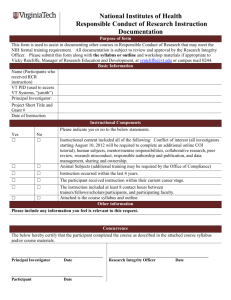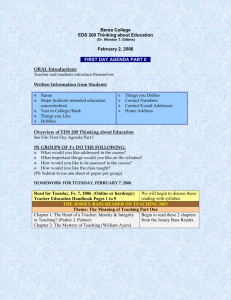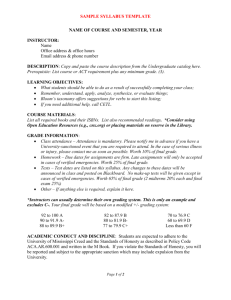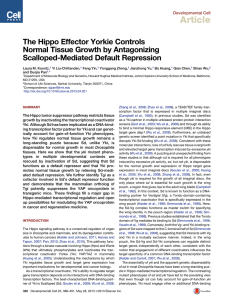The First Day - Innovative Educators
advertisement
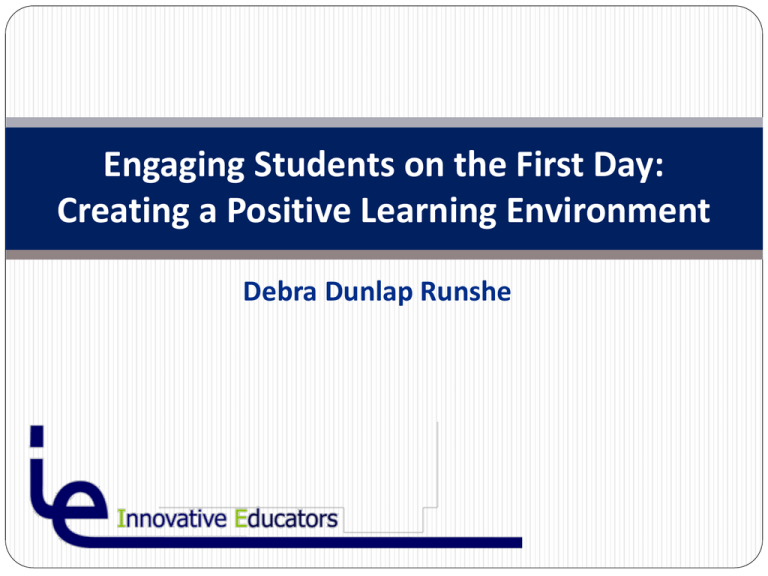
Engaging Students on the First Day: Creating a Positive Learning Environment Debra Dunlap Runshe Webinar Objectives By the end of this webinar, participants will: articulate reasons why the first day of class is important. discover ways to build community and positive relationships in your class. recognize important components to incorporate into the syllabus. identify strategies for creating a successful first day of class and beyond. The First Day … “The first day of class sets the tone for the rest of the term. It is natural for both students and instructor to feel anticipation, excitement, anxiety, and uncertainty.” (Davis, 2009) Before the First Day Visit the classroom prior to the first day. Know the answers to these questions: Where are the lights? Do I know how to use the equipment? What should I do in case of an emergency? Are there enough seats for the number of students registered? General Guidelines First impressions are important Build a sense of community Clarify expectations Set the tone Be productive First Impressions Be early, mingle Dress the part Introduce yourself Students with positive first-day experiences report higher levels of motivation and achieve higher grades than students with negative first-day experiences. (Wilson & Wilson, 2007) What do you want them to know about you? Introduce Yourself Effectively What characteristics do you want to convey about yourself? What will you need to say to convey those characteristics? What do you think students are trying to figure out about you? Introduce Yourself Effectively Introduction by Interview Introduce yourself and tell how long you have taught and what course(s) you will teach this fall. After your brief introduction, the floor will be open for two “interview” questions. Learn Your Students’ Names Strategies to accomplish this: Name plates Seating chart, student choice Office hours “interviews” Pictures Building Community Find someone who___??? Building Community “30 Second” Introductions 1. Name, major, etc. 2. Two of these: Home state High school you graduated from Pet(s) First, middle, last, only child 3. One of these in one sentence: What you want to do when you graduate Your favorite vacation destination Building Community Circle in the Circle Form two concentric circles Line up facing one person in the other circle After the prompt, discuss each question After discussion the inner circle will be directed to take one step to the right Building Community What strategies do you use to build community? Course Expectations Discuss the objectives of the course. Ask students to list the goals they hope to achieve by taking the course. Describe how you propose to spend class time. Give your students advice about how to succeed in your course. (Davis, 2009) Course Expectations Give a brief diagnostic pretest or survey. Ask students to work through a problem. Give an assignment for the next session. Ask students to write their reactions to the first day. (Davis, 2009) Do you go over the syllabus the first day? Learning About the Syllabus Role of the Syllabus Contract between students and faculty. Opportunity for faculty to convey expectations of students. “Road map” for the course (Nilson, 1998). Occasion to disclose your teaching values, enthusiasm for the subject, and research interests. Essential Elements of a Syllabus Instructor contact information Course description from university catalog and prerequisites Course information Required materials Course policies Course goals and objectives Content outline Grading standards and criteria Statement regarding accommodations for students with disabilities Disclaimer such as “The above schedule and procedures are subject to change.” Who are your students? Learner Characteristics Cognitive • Aptitude • Reading level • Language development • Learning styles • Computer Literacy • Prerequisite skills & knowledge Physiological • Age • General Health • Sensory perception (visual, auditory, tactile) Psychosocial • Interests • Motivation • Attitude toward subject • Academic self concept • Peer relationships • Beliefs • Cooperation/competition • Socioeconomic background • Racial/ethnic background • Working status (Smith & Ragan, 2005) Implications for Instruction Pace Relevance Attention Content of practice items and examples Number and difficulty of practice items and examples Amount/kind of structure Selection of instructional media Grouping of students Level of performance Reading level of instructional materials Vocabulary and terminology used Amount of time allowed Type of feedback Level of learner control Response mode (written, oral) (Smith & Ragan, 2005) Students’ Prior Knowledge Understanding Learning Styles provides a conceptual rationale for selecting appropriate teaching methods encourages students to develop alternative learning strategies helps explain differences in student performance increases student motivation Felder-Silverman Model Students learn about their learning preferences and strategies that will assist them in being successful. Their preferences fall on a continuum between: • active or reflective, • sensing or intuitive, • visual or verbal, and • sequential or global. (Felder & Silverman, 1988) http://www4.ncsu.edu/unity/lockers/users/f/felder/public/Learning_Styles.html Deciding Upon Essential Elements Objectives What should my students know? What should they be able to do? What type of activities can help students achieve the learning outcomes? How will I know that they have achieved the outcomes? Activities Assessments Importance of Goals and Objectives shifts emphasis from what the faculty member “covers” to what the student does communicates a logical instructional structure allows instructors to determine which teaching strategies and materials are effective facilitates fairness in testing and grading (Diamond, 2008) Importance of Goals and Objectives encourages student self-evaluation facilitates efficient student learning decreases student anxiety helps ensure equity between course sections improves communication among faculty and support staff (Diamond, 2008) Teaching Goals Inventory (TGI) The TGI is a tool for identifying and clarifying teaching goals. It was: developed by Thomas Angelo and Patricia Cross as part of the Classroom Research Project, funded by Ford and Pew grants, and shaped by nearly 5,000 college faculty who participated in the initial survey. (Angelo & Cross, 1993) Purpose of the TGI identify essential course goals clarify teaching priorities gauge the fit between your teaching priorities and your primary teaching role compare individual priorities with priorities of faculty at other institutions provide a process for linking formative assessments to goals (Angelo & Cross, 1993) TGI Clusters higher order thinking skills basic academic success skills discipline-specific knowledge and skills liberal arts and academic values work and career preparation personal development (Angelo & Cross, 1993) TGI Findings and Implications highest scoring clusters were higher order thinking skills and discipline-specific knowledge faculty teaching priorities and roles are related more to their academic discipline than to any other factor slight difference between teaching goals of instructors at different types of institutions (e.g., community colleges, four year public and private, etc.) (Angelo & Cross, 1993) Online Teaching Goals Inventory http://fm.iowa.uiowa.edu/fmi/xsl/tgi/data_entry.xsl?-db=tgi_data&-lay=Layout01&-view Other Elements of a Syllabus Conceptual structure of course Statement providing estimate of student work load Supplementary materials Grading rubric(s) Glossary of terms used in course Bibliography Campus resources List of co-curricular activities relevant to your course Space for names and telephone numbers of two or three classmates Statement on your beliefs about teaching and learning and instructional methods you will use What’s your instructional style? What’s your style? context? Style Mini lectures Discussion Small group Other? Context Web-enhanced Hybrid (blended) Fully online Identifying Effective Strategies Seven Principles for Good Practice in Undergraduate Education 1. Encourages student-faculty contact 2. Develops reciprocity and cooperation among students 3. Uses active learning techniques 4. Gives prompt feedback 5. Emphasizes time on task 6. Communicates high expectations 7. Respects diverse talents and ways of learning (Chickering & Gamson, 1987) Why use active learning? Research suggests active learning strategies: more frequently engage students. lead to increased student achievement. enhance students’ metacognitive skills. Retention of Information After 24 hours, what percent of information is retained by students in a lecture environment? a. 5% b. 10% c. 20% d. 40% e. 50% (Sousa, 2001) Retention after 24 hours (Sousa, 2001) Acquiring Learning Activities Search for Existing Learning Activities Create Your Own Learning Activities Pro: lots of resources Pro: flexibility to from which to choose Con: might not be exactly what you want create exactly what you want Con: learning curve to the applications may be high, and potentially costly Create Your Own For Free Hot Potatoes FIB, Quiz, Crossword puzzle, Sentence jumble, Matching activities Pro: Free! Con: Each activity must be created individually http://hotpot.uvic.ca/ Create Your Own For Free Flash Card Machine Students can create flash cards to help study for exams. Teachers can create flash cards for students. Pro: Free, and easily accessible online. Con: Flash cards are the only activity http://www.flashcardmachine.com Searching for Learning Activities Web sites to start your search: MERLOT www.merlot.org Wisconsin Online http://wisc-online.com/ RLO-CETL - The CETL for Reusable Learning Objects http://www.rlo-cetl.ac.uk/joomla/index.php Learning About Learning Objects http://www.learning-objects.net/ More! Additional Elements of a Syllabus For a course that utilizes the online environment Computer software Computer hardware (e.g., computer system, camera, microphone) Internet connection Additional contact information Student support services Content resources, links Navigation in the site Additional Elements of a Syllabus Tools and Technology Content presentations (text, screen casts, audio presentations) Posted resources Discussion forums Online chats Blogs and Wikis Assignment tools and gradebook Video conferencing meetings What element(s) might you add to your syllabus? Set the Tone for the Class Collect information from the students about issues related to course content Have students generate hypothesis about a typical problem in your course Make explicit connections Establish a culture of feedback Set the Tone for the Class Directed reading-thinking activity Connect course content to current events Preview “coming attractions” Stimulate their interest Facilitate a challenging task Ending the First Day of Class Bring closure to earlier activities Make an assignment Give time for reflection What might you do differently on the first day of class this semester? Thank you for your participation! Debra Dunlap Runshe Indiana University – Purdue University Indianapolis Center for Teaching and Learning 755 West Michigan Street, UL 1125 Indianapolis, IN 46202 Phone: 317-278-0589 Email: drunshe@iupui.edu Resources Angelo, T. A., & Cross, K. P. (1993). Classroom assessment techniques: A handbook for college teachers. San Francisco, CA: Jossey-Bass. Bain, K. (2004). What the best college teachers do. Cambridge, MA: Harvard University Press. Bianco-Mathis, V. & Chalofsky N. (1996). The adjunct faculty handbook. Thousand Oaks, CA: Sage Publications. Clement, M. C. (2010). First time in the college classroom: A guide for teaching assistants, instructors, and new professors at all colleges and universities. Lanham, MD: Rowman & Littlefield Education. Davis, B. G. (2009). Tools for teaching (2nd ed.). San Francisco, CA: Jossey-Bass. Diamond, R. M. (2008). Designing & Assessing Courses & Curricula: A Practical Guide. 3rd ed., San Francisco: Jossey-Bass. Resources Felder, R.M. & Silverman, L.K. (1988). Learning and teaching styles in engineering education. Engr. Education, 78(7), 674-681. Filene, P. G. (2005). The joy of teaching: A practical guide for new college instructors. Chapel Hill, NC: University of North Carolina Press. Fink, L. D. (2003). Creating significant learning experiences: An integrated approach to designing college courses. San Francisco, CA: Jossey-Bass. Gabriel, K. F. (2008). Teaching unprepared students: Strategies for promoting success and retention in higher education. Sterling, VA: Stylus. Jones, Thomas B. (2006). The missing professor: An academic mystery. Sterling, VA: Stylus Publishing, LLC. Resources Nilson, L. B. (2010). Teaching at its best: A research-based resource for college instructors. San Francisco, CA: Jossey-Bass. Smith, P. L. and Ragan, T. J. (2005). Instructional Design. 3rd Edition Hoboken, NJ: John Wiley & Sons, Inc. Sousa, D. A. (2001). How the brain learns: A classroom teacher's guide (2nd ed.). Thousand Oaks, CA: Corwin Press. Svinicki, M. & McKeachie, W. J. (2011). McKeachie's teaching tips: Strategies, research, and theory for college and university teachers. Belmont, CA: Wadsworth, Cengage Learning. Wilson, J. H. & Wilson, S. B. (2007). “The first day of class affects student motivation: An experimental study.” Teaching psychology. 34(4), 226-230.

